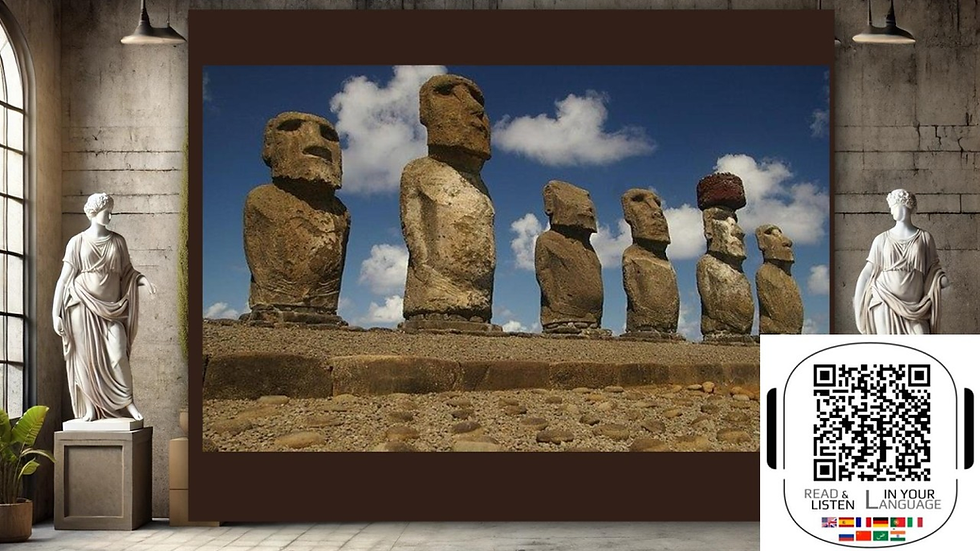The Moai Statues: Curating Memory That Watches Back
- carlo1715
- 3 ott
- Tempo di lettura: 3 min

They stand with backs to the sea, eyes hollowed by time, shoulders squared to the rising land. Some wear red stone topknots. Others lie fallen, face-down, as if mid-conversation with the earth. What unites them is their gaze, fixed not on the viewer, but on a people, a place, a purpose. These are the Moai: nearly 1,000 monolithic figures carved between the 13th and 16th centuries by the Rapa Nui people of Easter Island. Towering up to 33 feet tall and weighing as much as 80 tons, the Moai are more than archaeological wonders.
They are cultural declarations in basalt, and for museum curators, they pose urgent, resonant questions:
What do we do with memory we cannot move?
And what happens when that memory has already been moved?
Stone Ancestors, Not Stone Art
To Western eyes, the Moai might be read as “primitive sculpture” or “ancient relics.” But to the Rapa Nui, they are embodied ancestors, aringa ora, “living faces of the past.” Each Moai once stood atop a stone platform (ahu) facing inland, watching over the clan.
Their purpose wasn’t artistic. It was cosmological:
Connect the living with the dead.
Channel mana, spiritual power, from ancestor to land.
Anchor identity, balance, and sovereignty.
For museums, this radically shifts interpretation:
Frame the Moai not as “statues” but as relational beings.
Explore indigenous epistemologies where art is alive, not inert.
Highlight how Western categories of “artifact” can flatten spiritual complexity.
The Moai were never meant to be observed. They were meant to observe us. All Moai were quarried from volcanic tuff at Rano Raraku, many still lying unfinished like frozen thoughts mid-carving. But the real marvel? They were moved miles across rugged terrain to ceremonial sites, without wheels, cranes, or metal. Traditional oral histories say the Moai "walked", which modern theories now understand as rocking the statues upright with ropes, inch by inch.
This invites curatorial innovation:
Exhibit ancient ingenuity as engineering brilliance, not mystery.
Celebrate oral tradition as a legitimate historical method.
Use immersive design to let visitors experience the physicality of movement.
The Moai didn’t just reach their destination. They carried ancestral memory with every sway.
The Ethics of Displacement
Today, several Moai exist far from Rapa Nui:
The British Museum holds “Hoa Hakananai’a,” taken in 1868 by Royal Navy officers.
Other Moai fragments and statues exist in museums in Paris, Brussels, and Santiago.
The Rapa Nui have called for repatriation. Museums must now face:
What happens when a being made to stay is made to travel?
What does it mean to house a “living ancestor” in a gallery?
Can a museum steward memory it does not culturally own?
The future of these relationships must center:
Consultation with indigenous communities
Co-curation, not ownership
Return, where appropriate not as loss to the museum, but justice for the memory itself
If the Moai are faces of the past, their removal becomes a kind of cultural dismemberment.
A Moai in isolation is a question. A Moai in ecosystem is a complete story. The Moai do not smile. They do not command. But they witness from stone. Across colonization, conversion, theft, and climate crisis, they have remained as testaments to a culture that refused to forget itself. For museums, the Moai are more than prehistoric icons. They are teachers: Memory isn’t always what we preserve. Sometimes, it’s what watches us preserve it.



Commenti